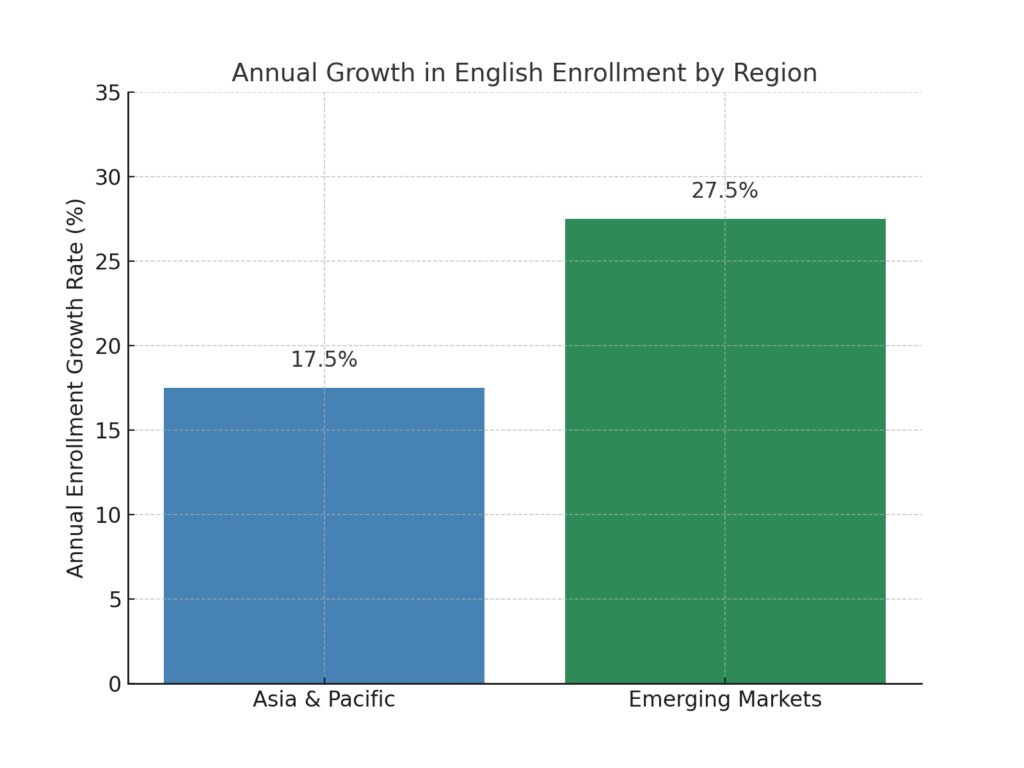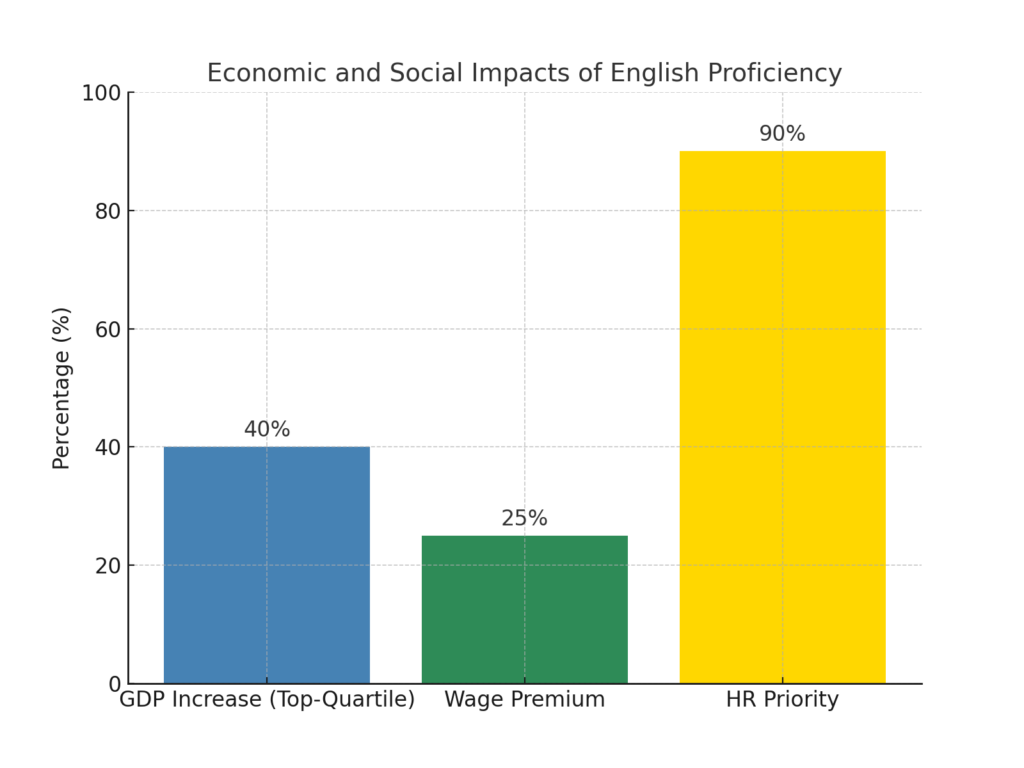English now boasts 1.75 billion learners worldwide, many of whom turn to digital platforms and AI-powered tools that adapt to their unique needs. Asia and emerging markets are witnessing enrollment growth rates above 20%, while Europe maintains consistently high proficiency scores that underline the language’s economic and social advantages. From a 30% wage premium for fluent speakers to a 40% higher national GDP in top-quartile proficiency countries, the data confirms English remains a powerful driver of both personal success and collective prosperity.
1. Global Trends and Statistics in English Learning
Worldwide Enrollment and Participation Rates
English is recognized as the world’s most popular second language. According to the British Council, approximately 1.75 billion people are learning or using English globally. This massive enrollment spans formal education systems, private language schools, and increasingly popular online platforms, reflecting a sustained and growing global demand for English proficiency.
Growth of English Learning Programs Over Time
Over the past two decades, the landscape of English language education has transformed dramatically. In the early 2000s, digital English learning was in its infancy, but today platforms like Duolingo boast over 300 million registered users worldwide. Additionally, accredited English programs have expanded by nearly 150% since the early 2000s, driven by technological advances and rising demand from both emerging economies and established markets.
Statistical Analysis of Proficiency Levels
International assessments, such as the EF English Proficiency Index, offer valuable insights into global English competency. In 2023, countries like the Netherlands, Sweden, and Denmark scored above 70 on a 100-point scale, indicating high proficiency levels. In contrast, many developing nations average around 50, highlighting significant disparities. Research from Cambridge Assessment English further suggests that an average learner achieves a B1 (intermediate) level after roughly 600 to 1,000 hours of focused study, underscoring the intensity and commitment required to reach effective proficiency.
English Language Learning at a Glance
2. Regional Variations: A Comparative Analysis
Trends in Asia and the Pacific
The Asia and Pacific region represents a powerhouse of English language learning, largely driven by its enormous population and rapid economic development. For example, in China alone, estimates suggest that over 300 million students are engaged in learning English, making it a key market for language education. Countries such as India, Japan, and South Korea have also witnessed explosive growth in English enrollment, with many institutions reporting annual increases of 15-20%. Furthermore, the widespread adoption of mobile learning platforms has accelerated this trend—recent data indicates that some apps have seen user growth rates exceeding 250% over the past five years.
European Adoption Patterns and Influences
In contrast to the dynamic growth in Asia, European countries have traditionally emphasized multilingual education from an early age. This is reflected in the consistently high proficiency levels across the continent. According to the EF English Proficiency Index 2023, countries like the Netherlands, Sweden, and Denmark score above 70 on a 100-point scale. European educational policies, which often integrate English as a core component of the curriculum, combined with strong cultural influences from American and British media, contribute to these favorable outcomes. Additionally, structured support and government initiatives in several European nations ensure steady improvements in language proficiency among learners.
Case Studies from Emerging Markets
Emerging markets offer insightful examples of how English learning is transforming societies. In Brazil, for instance, the private language school sector has experienced a 30% surge in enrollment over the past decade, driven by both economic aspirations and the desire for international connectivity. Similarly, Nigeria has seen significant government and private sector collaboration in English education, with some regions reporting annual enrollment growth of nearly 25%. Vietnam also serves as a notable case where public and private initiatives have combined to rapidly expand English language programs, underscoring the broader trend that English proficiency is increasingly viewed as a pathway to economic and social mobility in developing regions.

3. Economic and Social Impacts of English Proficiency
Economic Benefits and Global Competitiveness
English proficiency has become a key indicator of global competitiveness, particularly in sectors driven by international trade and investment. According to EF’s 2022 English Proficiency Index, countries scoring in the top quartile often enjoy a per capita GDP that is 30–50% higher than those with lower English proficiency. In addition, organizations such as the World Bank and the IMF have noted a positive correlation between strong English skills and increased foreign direct investment (FDI), as multinational corporations favor markets where effective communication with local partners and clients is seamless.
Job Market Advantages for English Speakers
Beyond macroeconomic gains, individuals with strong English skills frequently experience significant personal benefits. In many multinational companies, proficiency in English is now a standard requirement, leading to a wage premium of 20–30% for advanced speakers compared to non-English-speaking peers. Surveys conducted among global HR managers indicate that 9 out of 10 prioritize English communication skills in hiring, promotions, and international assignments. As a result, English speakers often find themselves with enhanced career mobility, the ability to work in global teams, and improved long-term earning potential.
Cultural Exchange and Social Integration
The influence of English extends well beyond financial incentives. With an estimated 70% of online content produced in English, the language serves as a gateway to a wealth of information and cultural exchanges. Individuals with higher English proficiency are more likely to participate in global forums, access diverse media, and engage in international dialogue. This exposure fosters mutual understanding and cooperation among different cultures, facilitating everything from study-abroad opportunities to cross-border friendships, and ultimately strengthening social integration on a global scale.

4. Demographics and Learner Profiles
Age, Gender, and Socioeconomic Distributions
English language learners come from a wide spectrum of ages, ranging from young children in early immersion programs to retirees seeking mental stimulation and social connections. While younger students typically have the advantage of institutional support (e.g., school curricula, after-school programs), adult learners often juggle work and family obligations, shaping their learning pace and commitment. Socioeconomic factors also play a crucial role; in many regions, higher-income households can afford private tutoring or advanced online subscriptions, whereas lower-income learners may rely more heavily on free digital resources and community programs. Interestingly, research suggests that gender gaps in English learning are narrowing worldwide, though in some societies, women still face cultural or financial barriers that limit consistent study.
Educational Backgrounds and Regional Trends
Educational background profoundly influences one’s approach to language learning. Students from countries with strong public education systems, particularly in Europe and parts of Asia, frequently benefit from early exposure and continuous reinforcement in English classes. In contrast, regions lacking robust language programs often see learners compensating with private academies or self-study methods. For instance, a growing trend in Latin America involves combining formal instruction with volunteer-led conversation clubs, allowing learners to practice fluency without incurring high costs. These grassroots efforts often foster a sense of community and mutual support, particularly in areas with limited educational resources.
Motivation and Learning Preferences
Motivations for learning English are as varied as the learners themselves. Career advancement and higher earning potential remain top drivers, especially in fast-growing economies where English proficiency is synonymous with professional opportunity. Others pursue English for travel, cultural exchange, or personal enrichment—like accessing a broader range of literature, film, and online content. This diversity in motivation also shapes individual learning preferences: some gravitate toward structured, textbook-based approaches, while others thrive in conversational environments or self-paced digital platforms. As a result, language educators and edtech companies alike have begun offering more tailored programs, recognizing that a “one-size-fits-all” model rarely satisfies the full spectrum of learner needs.

5. Technological Innovations in Language Education
Digital Platforms and Online Learning Trends
The rapid expansion of digital infrastructure worldwide has significantly reshaped the way people learn languages. According to recent market research, the global e-learning industry is projected to exceed USD 400 billion by 2027, with language education comprising approximately 15% of that market. The COVID-19 pandemic accelerated this shift, driving many traditional schools and language institutes to adopt hybrid or fully online models. As a result, usage of digital language platforms surged by more than 200% in several countries, indicating a clear preference for flexible and accessible learning solutions.
The Role of Artificial Intelligence in Language Acquisition
AI-driven applications and platforms have taken center stage in delivering personalized language instruction. From intelligent chatbots that simulate real-world conversations to advanced speech recognition systems, AI technologies can pinpoint individual weaknesses and adapt lesson plans accordingly. Estimates suggest that 45% of online language learners now utilize at least one AI-enhanced tool, reflecting a growing confidence in automated solutions. These tools often provide instant feedback on pronunciation, grammar, and vocabulary usage, which can expedite the learning process by offering targeted and efficient practice.
Mobile Applications and Adaptive Learning Technologies
Mobile-based apps like Duolingo, Babbel, and Busuu collectively boast well over 500 million downloads globally, illustrating the ubiquity of on-the-go learning. Their popularity stems from gamified lessons, bite-sized content, and adaptive learning algorithms that tailor exercises to a learner’s pace and proficiency level. Studies show that individuals who use adaptive technologies can improve test scores by as much as 20% compared to those who rely solely on traditional classroom materials. This personalized approach not only increases engagement but also makes language education more inclusive, reaching users who might otherwise have limited access to formal instruction.
1. Duolingo
Duolingo is a free, gamified language-learning platform with bite-sized lessons and fun challenges. Its intuitive interface and daily streak system motivate users to practice consistently. The app covers a wide range of languages, offering quick progress tracking and friendly reminders to keep learners engaged.
2. Babbel
Babbel focuses on real-life conversation skills through short, structured lessons developed by language experts. Its courses emphasize practical dialogues and context-based vocabulary, helping learners quickly gain confidence in everyday situations. Babbel’s personalized review system adapts to each user’s strengths and weaknesses, ensuring steady improvement over time.
3. Coursera
While not exclusively for language learning, Coursera offers a variety of English-related courses from top universities and institutions worldwide. Many of these courses integrate academic reading and writing, business English, and specialized professional communication modules. Learners benefit from a more formal curriculum, often culminating in certifications that bolster their credentials.
4. GET Global English Test
GET Global English Test offers a comprehensive online assessment designed to measure practical English skills across reading, writing, listening, and speaking. Its interactive format emphasizes real-life communication scenarios and situational language use, helping learners identify specific areas for improvement.
5. Cambly
Cambly pairs learners with native English speakers for real-time conversation practice. Through video chat, students can receive immediate feedback on pronunciation, grammar, and fluency. Because sessions are highly flexible, learners can schedule lessons at their convenience and tailor them to personal learning goals—whether that’s improving business communication, preparing for exams, or simply building confidence in everyday conversations.
English once lived on a single island, but it has long since packed its bags and traveled the globe—sneaking into corporate boardrooms in São Paulo, fueling tech innovations in Berlin, and sparking midnight study sessions in Tokyo. These days, people learn English for countless reasons: to land a dream job, connect with new cultures, or simply decode their favorite song lyrics. In the following pages, we’ll unpack the data, dig into regional trends, and explore how technology and shifting social dynamics are shaping one of the most widely pursued skills on the planet.
What’s your English level?
Discover your level now: A1/A2/B1/B2/C1/C2 and GET your certificate!




